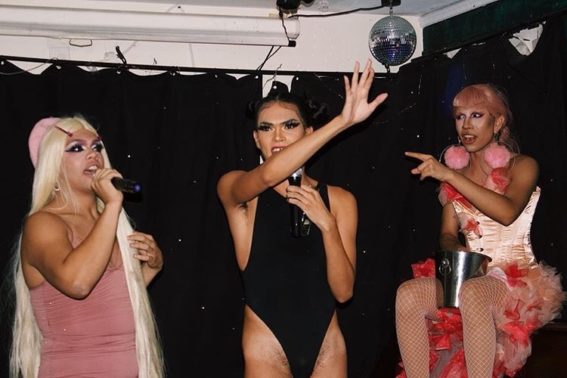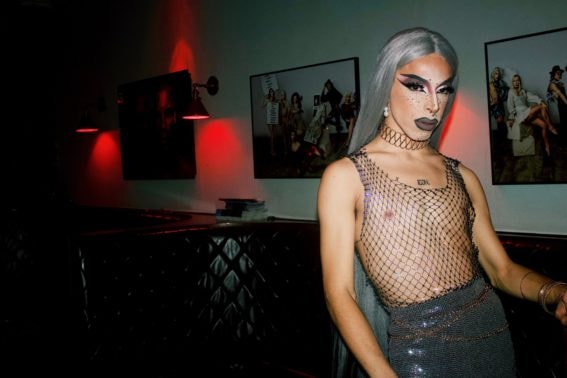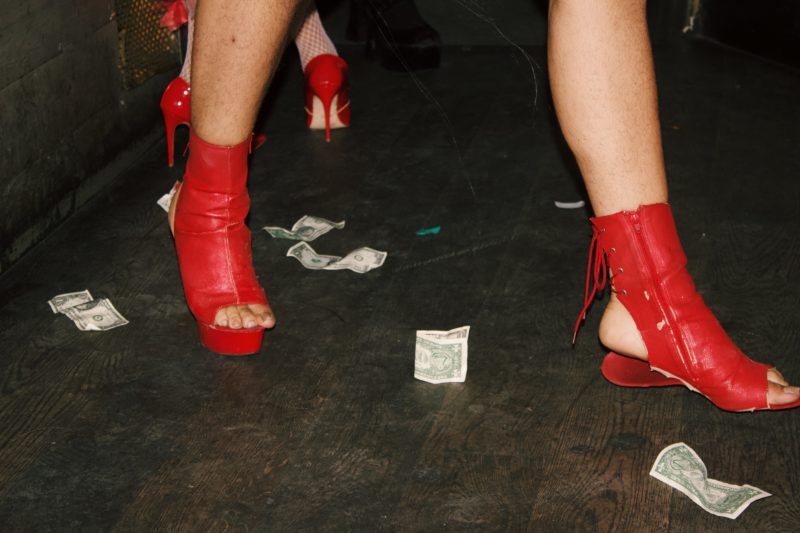A dark layer of slush coats Bushwick tonight—or maybe this is East Williamsburg, now. The lines keep moving; it’s hard to keep track. A Nor’easter was supposed to have hit New York City earlier this evening, but real snow gets vanquished by Brooklyn, and as I slosh down Montrose Avenue towards the Rosemont, I anticipate more radiating warmth.
The bar sits on a mostly-residential street, across from a soccer field awash in floodlight, and its black awning simply reads “63.” You’d never know that some of the most outlandish, boundary-pushing drag happening in New York—and maybe anywhere—is happening here. Unless, of course, you already know.
It’s 10:30 p.m. on a Wednesday, which means I’m technically half an hour late for the show. But drag time is its own thing. Some of the performers are here already, milling around and swapping their snow boots for heels, but others will arrive later, pushing show-time closer to midnight. No one minds. The Rosemont pulses with devoted community; I get the sense this room would wait forever, if it had to.
Drag has exploded in recent years, reaching larger audiences than ever before on social media and YouTube, and through RuPaul’s sprawling empire. The art form has often provided space for cisgender gay men to perform exaggerated femininity: this might be called “binary drag,” the older and more mainstream school, where prettiness and pageantry are prized and performers are expected to cross unambiguously over a perceived gender line. That stuff hasn’t disappeared. Cis men are still the majority of drag performers, and many queens still aim for drag that’s “fishy” (or female-passing) and polished. But here, in this dim sanctuary from the bitter Brooklyn cold, you sense a hunger for something more knotty. The drag is messy, activist, inclusive. Its performers identify all along the gender spectrum. It engages explicitly with contemporary politics, does not shy away from pain and ugliness, and is uninterested in restraint.

Crucially, a lot of drag at the Rosemont resists binary expectations. It’s a church of “genderfucking,” where high-femme makeup gets paired with flat, hairy chests. Bare breasts meet penile prosthetics. A cinched waist sits below an ample beard. Where some drag prizes clear-cut movement across gendered categories, this work worships the collapse of category altogether.
“There is no reason at all to subscribe to a binary in an art form that is meant to be subversive,” Jupiter Velvet tells me. She’s a trans femme queen based in Miami, but because of her deep Brooklyn ties (Brooklyn maven Merrie Cherry is her drag grandmother), she’s frequently in the Rosemont’s orbit. When I first saw her gliding across Bushwick, she had on a full face of impeccable makeup, a tight shirt whose round cut-outs revealed hairy nipples, and a trans pride flag draped over her shoulders, cascading down her body in baby blues and pinks. “No one should say, ‘This is how you should or shouldn’t look,’” she insists. “We don’t always need to be padded or shaved.”
For a school of drag to have liberated itself from binary rigidity is no small thing. The variety and fluidity here hint at larger trends within the art form, and have implications that reverberate beyond the drag world, too. Even with the careful distance that I—as a straight, cis woman—must maintain when I enter queer spaces, I feel animated by the revolutionary premise of this kind of drag. Because it embraces a radical softening of social category, it suggests something about how the world might be. How we all might live, even after we close our tabs at the end of the night, and stagger back to our muted routines.
Around 11:30, I see Paradise push her way through the thickening crowd. People stop her, kiss her on the cheek, ask how her week has been; she’s often here, arriving just a few minutes before she has to get onstage. She doesn’t need to spend as much time getting ready these days, not since she started hormone therapy two and a half years ago. “Every single day, it gets easier for me to get into makeup,” she’ll tell me later. “It doesn’t mean that my drag is any less valid, but I can spend twenty minutes on my face and look worlds more ‘womanly’—if that’s even something that people are striving for anymore—than some people who spend hours.” Paradise began performing before her transition, in her early college years. A lot of the draw, for her, was that drag provided a way to manifest feminine energy; when she came out as trans, the pieces fit. “I realized I was miserable out of drag, because I needed to be more femme all the time, as opposed to super-femme sometimes,” she’ll explain. Although onstage she is exaggerated, her drag character isn’t wildly different from her usual self—she performs in makeup close to her everyday look, without altering her voice or her body. She just adds a good wig and a little theater.
She disappears into the bathroom, which doubles as a dressing room. The Rosemont is long and narrow in the front—the entrance is a hallway, really, with the bar along one side—and it opens up into a slightly wider area, the performance space. There’s an upright piano, a tiny disco ball, and some twinkling lights back there. It’s otherwise small and dark and simply decorated: white and blue paint, brown leather booths, and framed photographs of queens on the walls. You can see the stylistic gamut in these photos: Crystal Mesh’s exaggerated “Drunk Aunt Barbie” ensembles next to West Dakota’s high fashion, flat-chested boy silhouettes (“There are histories of formalism within drag that go along more with female illusion, but my drag isn’t about presenting as a woman,” West Dakota explained). Some performers use “he/him” pronouns always; some, like Paradise, identify on the femme end of the gender spectrum, both in and out of drag; others, like Theydy Bedbug, were assigned female at birth and are non-binary; and still others, like Crystal, live as boys when the sun is out, switching from “he” to “she” pronouns as part of the fluid momentum of the day. Everything goes.
The Rosemont, which opened in its current incarnation in 2017, does share performers and crowds with other Brooklyn bars, bigger and more mainstream ones like Metropolitan and Macri Park. But it’s also doing its own thing. Artists tell me that here, they feel comfortable trying out new acts, including overtly political ones; performing their own songs live, something that is still often frowned upon at other venues; and dressing however they want. The Rosemont’s crowds—which have an alternative feel about them, a bold and scrappy vibrancy—congregate here for a reason. They’re drawn to the elasticity onstage, the permissiveness in the air. “The drag here is messy, not vanilla,” one regular tells me over the din. He sips his drink and settles on a word. “Genuine.”
By 12:15, the bar is packed and warm with body heat, its floors slick with melted snow. Paradise, who is soft and simple tonight in a white, long-sleeved lace slip, gets up to perform. Her number, “Let’s Hear It For the Boy,” unfolds: mid-song, exactly when Deniece Williams implores us to “give the boy a hand,” Paradise’s sleeves fall back. Where her hands should be, there are costume wrist-stumps, bloody and plastic and perfectly outrageous. They really do bleed—all over her dress, which seems whiter and more stainable all the time. During the final verses, the song is overlaid with RuPaul’s now-infamous interview soundbite from 2014—“I love the word ‘tranny,’” which he exclaimed happily to Marc Maron after being asked about off-limits language. “I love the word ‘tranny’…I love the word…”
RuPaul, now nearing sixty, has built a universe of opportunity for drag performers over the course of his career. But he’s a complicated figure in spaces like these. His aesthetic preferences are decidedly binary and “fishy,” and the politics he espouses are questionable at best: he’s wavered about allowing trans women to compete on his reality show, and has even likened drag queens who take estrogen to Olympic athletes on steroids. Rosemont regulars appreciate how hypocritical it is for RuPaul to reclaim “tranny,” a slur lobbed at the very people he often tries to exclude. When his voice blares through the speaker during Paradise’s act, the response from the crowd is immediate—shrieks and boos and a dozen volleyed retorts.

Exclusion is a major problem, and it still happens, even in the Brooklyn scene. I hear about a party in the borough last summer from which trans women were categorically asked to leave; meanwhile, RuPaul begins each episode with “Gentlemen, start your engines,” an alienating statement for a performer who is not a man to hear. But another, more philosophical problem is that strictly binary schools of drag dictate not only what the aesthetic destination should be, but that there should be an aesthetic destination at all. If a queen softening her features with estrogen gains a competitive advantage, surely she’s headed somewhere? An agreed-upon somewhere? When I ask whether RuPaul-esque prescriptive standards have a place at the Rosemont, Crystal Mesh dismisses the idea. “We’re not trying to fit in anybody’s box,” she says, shaking her crown of bubblegum-pink curls. She’s perched on a barstool, crossing long legs that are unshaved tonight, and bare despite the weather. The Rosemont, as Crystal suggests, resists containment of many types: performance styles, gender expressions, start times. And the goalposts for drag here keep moving, or were maybe fully immolated already.
“You can go have your little gentleman’s race,” Paradise will say later, as if to RuPaul himself. “I’m gonna wait for the next big thing.”
“I think this is a continuation of an aesthetic that has always been there,” said drag historian and New School faculty member Joe Jeffreys of what’s going in Brooklyn, in spaces like the Rosemont. “This has roots in the Cockettes,” he said, “who get a little bit buried in the history.” The Cockettes were a collective of genderfucking, drag-oriented performers well-known in the 1970s San Francisco scene. But as Jeffreys points out, although genderfuck has long existed in the drag world, it has often been—and still often is—sidelined. “People are disturbed by it,” he explained. “Even if you’re a man in a dress, people want to be able to identify you as such. To identify the end of the binary that you are shooting for.”
Queasiness about non-binary aesthetics—about bodies that cannot be quickly, easily catalogued—explains why, even as drag enjoys its current explosive popularity, it is still unusual to see a cis queen onscreen or in a magazine who is unpadded or unshaved. And it explains why performers who identify as trans or non-binary are basically not in the mainstream public eye at all.
But spaces like the Rosemont, where genderfucking and gender expansiveness are enthusiastically embraced, suggest a promising future. Jupiter Velvet wants her drag to send a crucial message to trans and gender nonconforming people: “I want to use my body as a vessel,” she said, “to let other trans people know that there is no right or wrong way to exist.” The glamorous headshots scattered across her Instagram often feature the dark chest hair that reaches up to her collarbone; the caption for a recent one was “Just ur daily reminder trans women define their own femininity and being hairy doesn’t make you any less valid as a woman!!!” 1,900 people liked it in two days.
The politics can get explicit in these circles. Not long ago, I watched a bearded queen dressed as Little Red Riding Hood stab her wolf pursuer, and then pull off her cape to reveal “SOCIALISM MUST WIN” stitched into its underside. While “Why Try To Change Me Now” played through enormous warehouse speakers, Brooklyn king Mr. Lee Valone pulled a sock out from between his bound breasts and stuffed it down into his underwear; and, in the same warehouse that same weekend, Theydy Bedbug ripped through phallic produce with their teeth. When I asked Jupiter Velvet about the less political stuff—the Alyssa Edwards-esque pageantry, the straightforward lip-syncing to Ariana Grande—a grin sidled into her voice. “Well, mama, you can serve me everyday girl getting on the commuter train to her job at Teen Vogue, but drag should be pushing the envelope.”
I’m drawn to all kinds of drag, including shimmery older schools. I love the palpable joy that is, for me, the hallmark of any drag show, the flash of unapologetic elation that leaves a whole room giddy. But what moves me most is the example drag can set for those who seek freedom. Freedom from rules for comportment, from assumption and expectation, from categorical divisions and frustratingly inflexible taxonomy—a freedom endorsed with particular sincerity here, in the vibrant Brooklyn throngs. This drag is allowance, a license to expand. The universe it conjures and projects is less static, more generous, and full of creative potential. It encourages us to be shape-shifting creatures in a liquid world, and so, to be free.
Late at the Rosemont on that snowy Wednesday, I watched Paradise finish her number, smiling through smeared stage blood. She hustled to the bathroom to rinse off, and the show continued. This is the drag of now, I thought—the drag of flux and movement, the forward-looking stuff. It may not quite be happening on our televisions yet, but it’s happening here, across from an empty soccer field, long after the floodlights have blinkered on. This is the glittering fringe.

